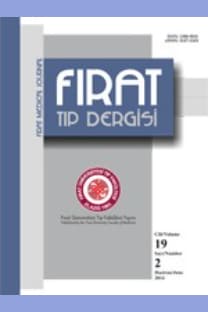Thinprep ve konvansiyonel servikovajinal smearlarin histopatolojik sonuçlarının karşılaştırılması
Comparison of histopathological results of thinprep and conventional cervicovaginal smears
___
- 1. Jemal A, Bray F, Center M, Ferlay J, Ward E, Forman D. Global cancer statistics. CA Cancer J Clin 2011; 61: 69 -90.
- 2. Valdespino VM, Valdespino VE. Cervical cancer screening: state of the art. Curr Opin - Obstet Gynecol 2006; 18: 35 -40.
- 3. Solomon D, Davey D, Kurman R, et al. Bethesda 2001 Workshop: the 2001 Bethesda system-terminology for reporting the results of cervical cytology. JAMA 2002; 287: 2114 -9.
- 4. Karabacak T, Aydın Ö, Düşme z D, P olat A, Cinel L, Eğilmez R. [Limitation, inadequacy rates and reasons in cervicovaginal smears (2832 cases) ] Patoloji Bülteni 2001; 18: 22-5.
- 5. McNeeley SG. New cervical cancer screening techniques. Am J Obstet Gynecol 2003; 189: 40 -1.
- 6. Richartın Richart RM. Natural history of cervical intraepithelial neoplasia. Clin Obstet Gynecol 1967; 10: 748 - 84.
- 7. Anschau F, Guimarães Gonçalves MA. Discordance between cytology and biopsy histology of the cervix: what to consider and what to do. Acta Cytol 2011; 55: 158 -62.
- 8. Turkish Cervical Cancer and Cervical Cytology Research Group. Prevalence of cervical cytological abnormalities in Turkey. Int J Gnecol and Obs 2009; 106: 206 -9.
- 9. Atilgan R, Celik A, Boztosun A, Ilter E, Yalta T, Ozercan R. Evaluation of cervical cytological abnormalities in Turkish population. Indian J Pathol Microbiol 2012; 55: 52-5.
- 10. ASCUS - LSIL Traige Study (ALTS) Group. A randomized trial on the management of low- grade squ- amous intraepithelial lesion cytology interpretations. Am J Obstet Gynecol 2003; 188: 1393 - 400.
- 11. Abike F, Engin AB, Dunder I, Tapisiz OL, Aslan C, Kutluay L. Human papilloma virus persistence and neopte - rin, folate and homocysteine levels in cervical dysplasias. Arch Gynecol Obstet 2011; 284: 209 -14.
- 12. Infantolino C, Fabris P, Infantolino D, et al. Usefulness of human papillomavirus testing in the screening of cervical cancer precursor lesions: a retrospective study in 324 cases. Eur J Obstet Gynecol Reprod Biol 2000; 93: 71 -5.
- 13. Fallani MG, Pena C, Fambrini M, Marchionni M. Cervical cytologic reports of ASCUS and LSIL. Cyto - histological correlation and implication for management. Minerva Ginecol 2002; 54: 263 -9.
- 14. Yaltı S, Gürbüz B, Bilgiç R, Çakar Y, Eren S. Evaluation of cytologic screening results of the cervix. Int J Gynecol Cancer 2005; 15: 292 -4.
- 15. Boztosun A, Mutlu AE, Özer H, Aker H, Yanık A. [The evaluation of colposcopic biopsy results in patients with epithelial cell abnormalities at cervicovaginal smear] Türk Jinekolojik Onkoloji Derg 2012; 15: 13 -9.
- 16. Yazıcı F, Tazegül A, Esen H, Çelik Ç. [The Evaluation of the Biopsy Results Taken Under Colposcopy in Patients with Abnormal Cervicovaginal Smear Results ] Turkiye Klinikleri J Gynecol Obst 2011; 21: 83 -8.
- 17. Duggan MA, Khalil M, Brasher PM, Nation JG. ThinPrep yield o f confirmed tests however was almost 50% higher than the conventional test. Cytopathology 2006; 17: 73 -81.
- 18. Koltz BR, Russell DK, Lu N, Bonfiglio TA, Varghese S. Effect of Thin Prep(®) imaging system on laboratory rate and relative sensitivity of atypical squamous cells, high- grade squamous intraepithelial lesion not excluded and high - grade squamous intraepithelial lesion interpretations. Cytojournal 2013; 10: 6.
- 19. Miller FS, Nagel LE, Kenny-Moynihan MB. Implementation of the ThinPrep imaging system in a hig h volume metropolitan laboratory. Diagn Cytopathol 2007; 35: 213 -7.
- ISSN: 1300-9818
- Yayın Aralığı: 4
- Başlangıç: 2015
- Yayıncı: Fırat Üniversitesi Tıp Fakültesi
Amenore ile seyreden De Morsier Sendromu: Olgu sunumu
Orkide KUTLU, İBRAHİM ŞAHİN, ABDULLAH SAKİN, Bahri EVREN
Sertaç USTA, Vural SOYER, Barıs SARICI, Turgut PİŞKİN, Bülent ÜNAL
Degenerated primary retroperitoneal leiomyoma: A rare case
OKTAY ÜÇER, Bilal GÜMÜŞ, Hasan AYDEDE, Ali Rıza KANDİLOĞLU
Kolorektal kanserin karaciğer metastazlarında cerrahi tedavi
ÜNAL BAKAL, MEHMET SARAÇ, TUGAY TARTAR, AHMET KAZEZ
Does varicocele affect testicular arterial blood flow?
OKTAY ÜÇER, Mehmet Fatih ZEREN, SERDAR TARHAN, Bilal GÜMÜŞ
Primeri bilinmeyen kanserlerde primer odak tespitinde PET/BT' nin etkinliği
FİKRİ SELÇUK ŞİMŞEK, Emre ENTOK
Chronic otitis media in the etiology of benign paroxysmal positional vertigo
İsrafil ORHAN, EROL KELEŞ, Mehmet KELLEŞ
Hylan GF-20 ve metil-prednizolonun laparotomi yapılan ratlarda yapışıklık oluşması üzerine etkileri
Cemalettin CAMCI, CÜNEYT KIRKIL, Fatih EROL, Erhan AYGEN, OSMAN DOĞRU, Refik AYTEN
Feride ÇETİN, NEVZAT GÖZEL, Nalan KAYA, EBRU ÖNALAN, ALİ GÜREL, RAMAZAN ULU, TUNCAY KULOĞLU, EMİR DÖNDER
